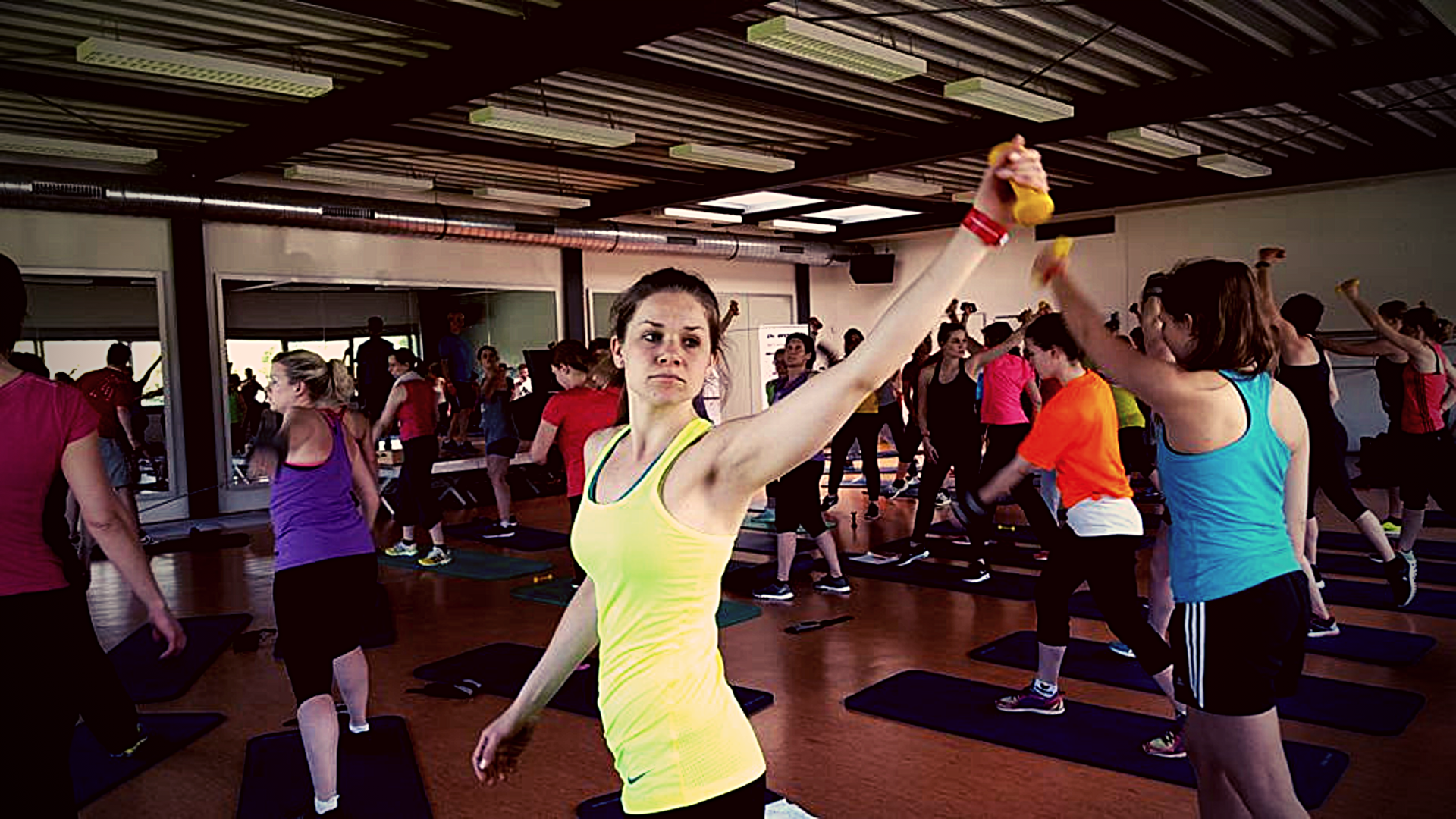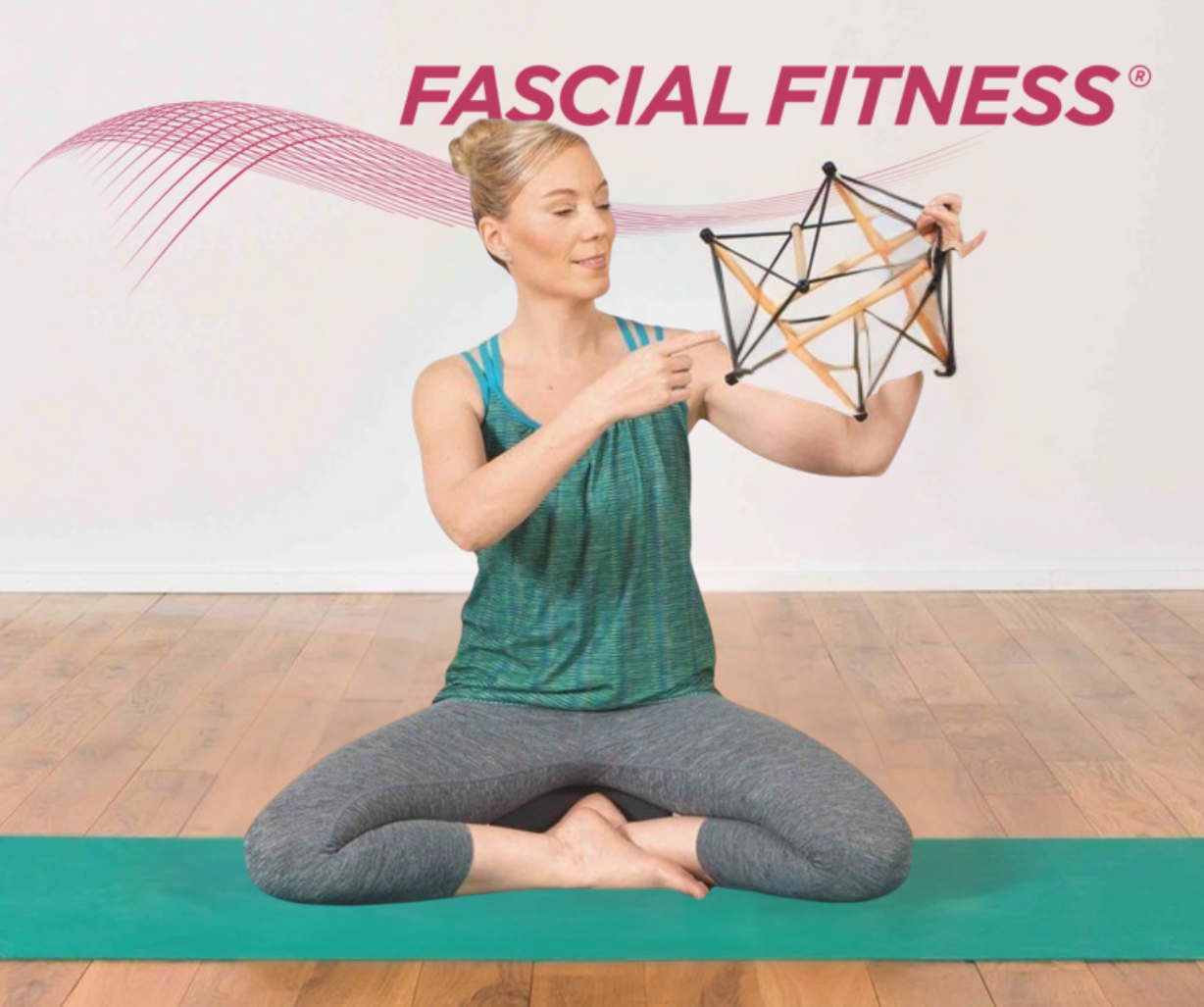(Excerpt from “Fascial Fitness: Fascia oriented training for bodywork and movement thereapies” by Divo G. Muller & Robert Schleip)
A dynamic muscular loading pattern in which the muscle is both activated and extended promises a more comprehensive stimulation of fascial tissues. This can be achieved by muscular activation (e.g. against resistance) in a lengthened position while requiring small or medium amounts of muscle force only. Soft elastic bounces in the end ranges of available motion can also be utilized for that purpose. The following guidelines are developed to make such training more efficient.
1. Preparatory Counter-Movement
Here we make use of the catapult effect as described above. Before performing the actual movement, we start with a slight pre-tensioning in the opposite direction. This is comparable with using a bow to shoot an arrow; just as the bow has to have sufficient tension in order for the arrow to reach its goal, the fascia becomes actively pre-tensioned in the opposite direction. Using one‘s muscle power to push the arrow‖ would then rightfully be seen as foolish, in this extreme example of an elastic recoil movement. In a sample exercise called the flying sword, the pre-tensioning is achieved as the body‘s axis is slightly tilted backward for a brief moment; while at the same time there is an upward lengthening (Figure 5). This increases the elastic tension in the fascial body- suit and as a result allows the upper body and the arms to spring forward and down like a catapult as the weight is shifted in this direction.
The opposite is true for straightening up – the mover activates the catapult capacity of the fascia through an active pre-tensioning of the fascia of the back. When standing up from a forward bending position, the muscles on the front of the body are first briefly activated. This momentarily pulls the body even further forward and down and at the same time the fascia on the posterior fascia is loaded with greater tension.
The energy which is stored in the fascia is dynamically released via a passive recoil effect as the upper body ̳swings‘ back to the original position. To be sure that the individual is not relying on muscle work, but rather on dynamic recoil action of the fascia, requires a focus on timing – much the same as when playing with a yoyo. It is necessary to determine the ideal swing, which is apparent when the action is fluid and pleasurable.
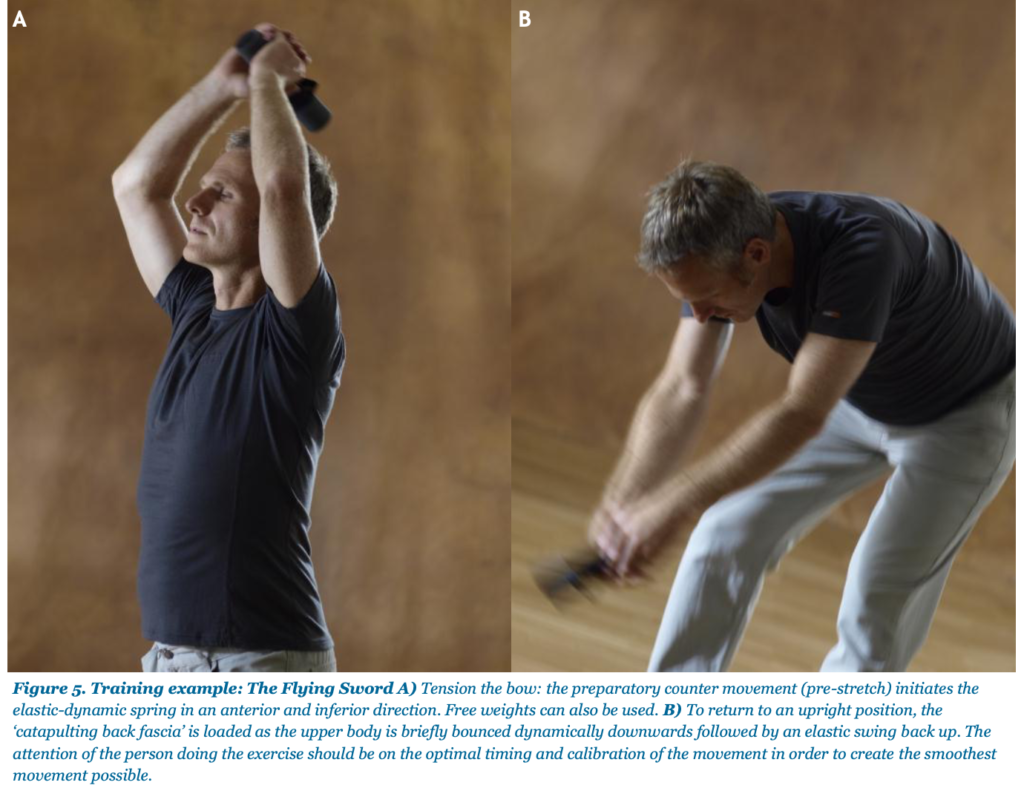
2. The Ninja Principle
This principle is inspired by the legendary Japanese warriors who reputedly moved as silent as cats and left no trace. When performing bouncy movements such as hopping, running and dancing, special attention needs to be paid to executing the movement as smoothly and softly as possible. A change in direction is preceded by a gradual deceleration of the movement before the turn and a gradual acceleration afterwards, each movement flowing from the last; any extraneous or jerky movements should therefore be avoided (see Figure 6).
Normal stairs become training equipment when they are used appropriately, employing gentle stepping. The production of ̳as little noise as possible‘ provides the most useful feedback – the more the fascial spring effect is utilized, the quieter and gentler the process will be. It may be useful to reflect on the way a cat moves as it pre- pares to jump; the feline first sends a condensed impulse down through its paws in order to accelerate softly and quietly, landing with precision.
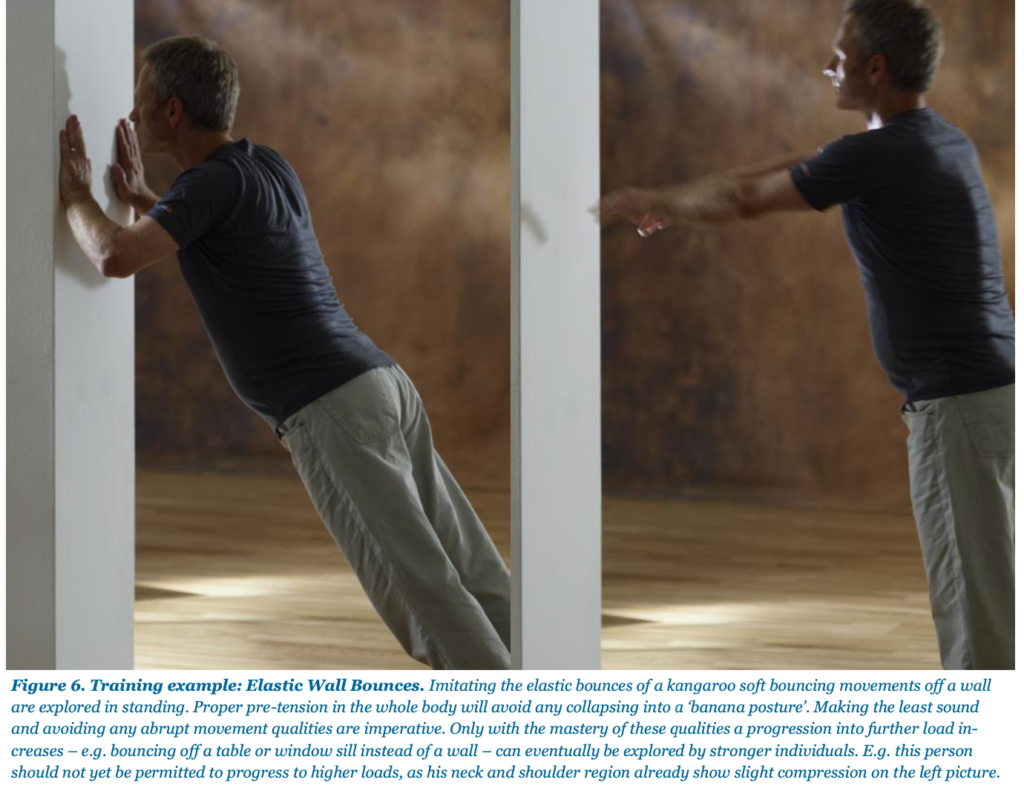
3. Dynamic Stretching
Rather than a motionless waiting in a static stretch position a more flowing stretch is suggested. In fascial fit- ness there is a differentiation between two kinds of dynamic stretching: fast and slow. The fast variation may be familiar to many people as it was part of the physical training in the past. For the past several decades this bouncing stretch was considered to be generally harmful to the tissue, but the method‘s merits have been con- firmed in contemporary research. Although stretching immediately before competition can be counterproductive, it seems that long-term and regular use of such dynamic stretching can positively influence the architecture of the connective tissue in that it becomes more elastic when correctly performed (Decoster et al. 2005). Muscles and tissue should first be warmed up, and jerk- ing or abrupt movements should be avoided. The motion should have a sinusoidal deceleration and acceleration shape each direction turn; this goes along with a smooth and ̳elegant‘ movement quality perception. Dynamic, fast stretching has even more effect on the fascia when combined with a preparatory countermovement as was previously described by Fukashiro et al. (2006). For example, when stretching the hip flexors a brief backward movement should be introduced before dynamically lengthening and stretching forwards.
The long myofascial chains are the preferred focus when doing slow dynamic stretches. Instead of stretching iso- lated muscle groups, the aim is finding body movements that engage the longest possible myofascial chains (Myers 1997). This is not done by passively waiting as in a lengthening classical Hatha yoga pose, or in a conventional isolated muscle stretch. Multidirectional movements, with slight changes in angle are utilized; this might include sideways or diagonal movement variations as well as spiraling rotations. With this method, large areas of the fascial network are simultaneously involved (Figure 7).
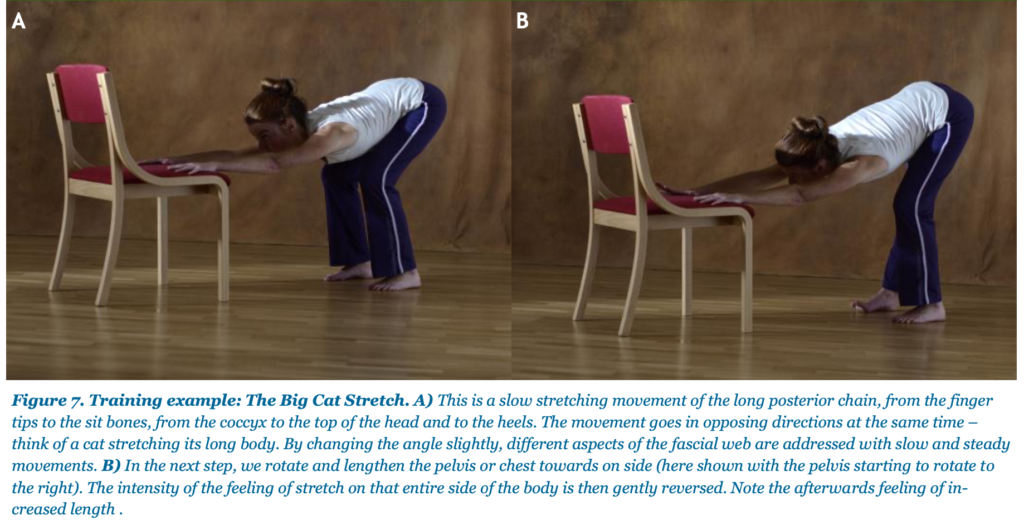
4. Proprioceptive Refinement
The importance of proprioception for movement control is made clear by the case of Ian Waterman, a man repeatedly mentioned in scientific literature. This impressive man contracted a viral infection at the age of 19 which resulted in a so-called ̳sensory neuropathy‘. In this rare pathology, the sensory peripheral nerves which provide the somato-motor cortex with information about the movements of the body are destroyed, while the motor nerves remain completely intact. This means that Mr. Waterman can move, but he can‘t ̳feel‘ his movements. After some time, this giant of a man be- came virtually lifeless. Only with an iron will and years of practice did he finally succeed in making up for these normal physical sensations, a capacity that is commonly taken for granted. He did so with conscious control that primarily relies on visual feedback. He is currently the only person known with this affliction that is able to stand unaided, as well as being able to walk (Cole 1995).
Observation of the way Waterman moves is similar to the way patients with chronic back pain move. When in a public place if the lights unexpectedly go out, he clumsily falls to the ground (see BBC documentary: The man who lost his body). Springy, swinging movements are possible for him only with obvious and jerky changes in direction. If doing a classical stretching program with static or active stretches, he would appear normal. As for the dynamic stretching that is part of our fascial training, he is clearly not capable, as he lacks the proprioception needed for fine coordination.
It is interesting to note here that the classical ̳joint receptors‘ – located in joint capsules and associated ligaments – have been shown to be of lesser importance for normal proprioception, since they are usually stimulated at extreme joint ranges only, and not during physiological motions (Lu et al 1985). On the contrary, proprioceptive nerve endings located in the more superficial layers are more optimally situated as here even small angular joint movements lead to relatively distinct shearing motions. Recent findings indicate that the superficial fascial layers of the body are in fact more densely populated with mechano-receptive nerve endings than tissue situated more internally (Stecco et al. 2008).
For this reason a perceptual refinement of shear, gliding and tensioning motions in superficial fascial membranes is encouraged. In doing this, it is important to limit the filtering function of the reticular formation as it can markedly restrict the transfer of sensations from movements which are repetitive and predictable. To prevent such a sensory dampening, the idea of varied and creative experiencing becomes important. In addition to the slow and fast dynamic stretches noted above as well as utilizing elastic recoil properties an inclusion of ̳fascial refinement‘ training is recommended in which various qualities of movement are experimented with, e.g. extreme slow-motion and very quick, micro- movements which may not even be visible to an observer and large macro movements involving the whole body. Here it is common to place the body into unfamiliar positions while working with the awareness of gravity, or possibly through exploring the weight of a training partner.
The micro-movements are inspired by Emily Conrad‘s Continuum Movement (Conrad 1997). Such movement is active and specific and can have effects which are not possible with larger movements. In doing these coordinated fascial movements, it appears possible to specifically address adhesions, for example between muscle septa deep in the body. In addition such tiny and specific movements can be used to illuminate and bring awareness to perceptually neglected areas of the body (Figure 8). Thomas Hanna uses the label ̳sensory-motor amnesia‘ for such places in the body (Hanna 1998).
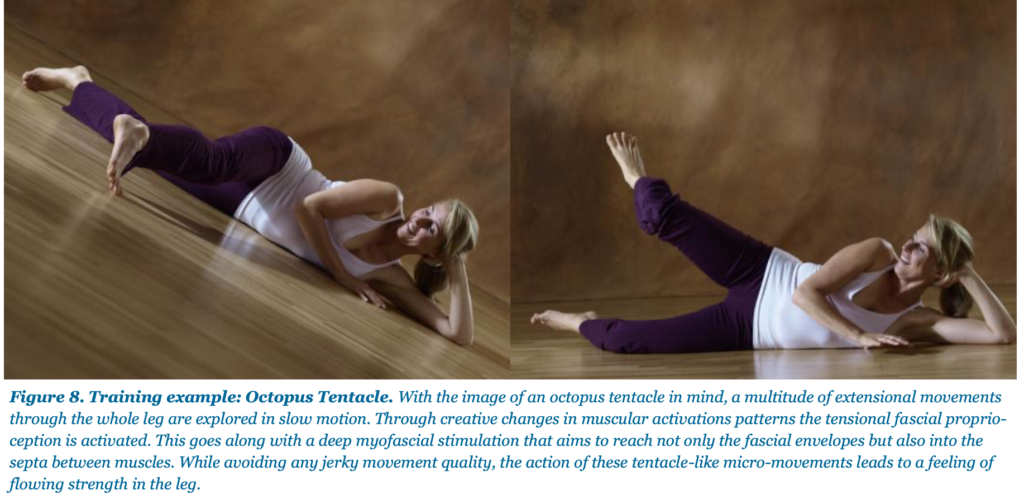
5. Hydration and Renewal
The video recordings of live fascia Strolling Under the Skin by Dr Jean-Claude Guimbertau have helped our understanding of the plasticity and changing elasticity of the water-filled fascia. This awareness has proven to be especially effective when incorporated into the slow dynamic stretching and the fascial refinement work. An essential basic principle of these exercises is the under- standing that the fascial tissue is predominantly made up of free moving and bound water molecules. During the strain of stretching, the water is pushed out of the more stressed zones similarly to squeezing a sponge (Schleip & Klingler 2007).With the release that follows; this area is again filled with new fluid which comes from surrounding tissue as well as the lymphatic and vascular network. The sponge-like connective tissue can lack ad- equate hydration at neglected places. The goal of exercise is to refresh such places in the body with improved hydration through specific stretching to encourage fluid movement.
Here proper timing of the duration of individual loading and release phases is very important. As part of modern running training, it is often recommended to frequently intercept the running with short walking intervals (Galloway 2002). There is good reason for this: under strain the fluid is pressed out of the fascial tissues and these begin to function less optimally as their elastic and springy resilience slowly decreases.
The short walking pauses then serve to re-hydrate the tissue as it is given a chance to take up nourishing fluid. For an average beginning runner for example, the authors recommend walking pauses of one to three minutes every 10 minutes. More advanced runners with more developed body awareness can adjust the optimal timing and duration of those breaks based on the presence (or lack) of that youthful and dynamic rebound: if the running movement begins to be feel and look more dampened and less springy, it is likely time for a short pause. Similarly, if after a brief walking break there is a noticeable return of that gazelle-like rebound, then the rest period was adequate.
This cyclic training, with periods of more intense effort interspersed with purposeful breaks, is recommended in all facets of fascia training. The person training then learns to pay attention to the dynamic properties of their fascial ―bodysuit‖ while exercising, and to adjust the exercises based on this new body awareness. This also carries over to an increased ̳fascial embodiment‘ in everyday life. Preliminary anecdotal reports also indicate a preventative effect of a fascia oriented training in relation to connective tissue overuse injuries.
The use of special foam rollers can be useful tools for inducing a localized ̳sponge-like‘ temporary tissue de- hydration with resultant renewed hydration. However firmness of the roller and application of the bodyweight needs to be individually monitored. If properly applied and including very slow and finely-tuned directional changes only, the tissue forces and potential benefits could be similar to those of manual myofascial release treatments (Chaudhry et al. 2008). In addition, the localized tissue stimulation may serve to stimulate and fine-tune possibly inhibited or de-sensitized fascial proprioceptors in more hidden tissue locations (Figure 9).

6. Sustainability: The Power of a Thousand Tiny Steps
An additional and important aspect is the concept of the slow and long-term renewal of the fascial network. In contrast to muscular strength training in which big gains occur early on and then a plateau is quickly reached wherein only very small gains are possible, fascia changes more slowly and the results are more last- ing. It is possible to work without a great deal of strain – so that consistent and regular training pays off. When training the fascia, improvements in the first few weeks may be small and less obvious on the outside. However, improvements have a lasting cumulative effect which after years can be expected to result in marked improvements in the strength and elasticity of the global facial net (Figure 10) (Kjaer et al. 2009). Improved coordination as the fascial proprioception becomes refined is probable.

A bit of Eastern philosophy might help in the motivation of impatient Westerners looking for quick gains: to be
supple and resilient like a bamboo requires the devotion and regular care of the bamboo gardener. He nurtures his seeds over a long period of time without any visible positive result. Only after enduring care does the first bamboo seedling become visible as it pushes its way toward the sky. From then on it grows steadily upwards until it dwarfs its neighbors in height, flexibility and resistance to damage. It is therefore suggested that training should be consistent, and that only a few minutes of appropriate exercises, performed once or twice per week is sufficient for collagen remodeling. The related renewal process will take between six months and two years and will yield a lithe, flexible and resilient collagenous matrix.
For those who do yoga or martial arts, such a focus on a long-term goal is nothing new. For the person who is new to physical training, such analogies when combined with a little knowledge of modern fascia research can go a long way in convincing them to train their connective tissues. Of course fascial fitness training should not re- place muscular strength work, cardiovascular training and coordination exercises; instead it should be thought of as an important addition to a comprehensive training program.

